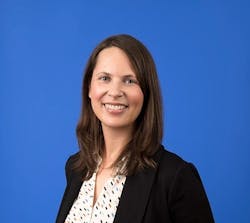The Power of Opportunity in a More Diverse Workplace
The natural order is for things to change. What was once novel should become commonplace. In that vein, it’s time that women in environment, health and safety (EHS) professions need no longer be differentiated for their gender. They should be recognized for their accomplishments in the field. The fact that they are women ought to be a side note, if that.
“The needle is moving but needs to move faster,” says Maria Gutierrez, director, corporate responsibility and sustainability at Bendix Commercial Vehicle Systems, an America’s Safest Companies winner in 2020. “While we’re still in the minority, I am seeing more women in the safety field.”
To move more quickly, Gutierrez feels the profession needs to concentrate on building awareness that safety is a good career for women. “The expression that ‘you can’t be what you can’t see’ applies here.
"We need to show more women in these jobs and explain that women don’t need to give up their own personalities in order to be successful in this field. They just need to have a passion for the job.”
Passion for the job is exactly how Rachel Bugaris, business development manager at Panduit, would explain her experience in the EHS field. She began her career with Rockwell Automation in the leadership development program. With a degree in electrical engineering, she rotated positions at Rockwell and raised her hand to work on electrical safety standards as a way to make her mark as a young woman in a workforce of mostly older men.
“Tackling this area gave me an opportunity to know as much about something as everyone on the team did,” Bugaris says. “I found my passion in the research and development area, where I was able to ask why we were doing things the same way and was there a better way to do this.”
Gutierrez joined Bendix 25 years ago with a mechanical engineering degree and the notion that she was equal to all things. However, once she entered the workforce, she was surprised that things looked different.
“I saw myself working harder, but I could present my point in an informed manner and was able to gain respect partly due to my technical background," Gutierrez says. "But I had to prove myself.”
And that she did. “What I found interesting is that my soft skills earned the respect of my co-workers. I have high expectations of those who work for me. They know they have to work at their highest level and have told me that when they work with contractors, they make it clear that their boss won’t accept anything less. This makes me proud.”
What’s Holding Back Progress?
Given the accomplishments exemplified by these two women, why aren’t we seeing more forward progress for women as a whole throughout the profession?
“Why aren’t more women in upper management or senior executive roles?” Ferri asks. “It’s because they are hitting the glass ceiling. We see women in field safety positions, site managers and some safety directors, but it’s rare to see them in vice president of EHS roles.”
One reason for the lack of women in leadership roles could stem from outdated ways of thinking. Ferri surmises that some women are choosing to not put themselves out there for those higher roles. There is the oft-quoted research that shows that men apply for jobs where they meet only 60% of the qualifications, but women apply only if they meet 100% of them. “Women need to be stretching and pushing themselves,” says Ferri.
Pushing is not quite how Bugaris would describe the upward trajectory of her career, but instead she would say that women should be cognizant of their value and ask for what they need.
“When I became a remote worker due to COVID-19, I felt that wasn’t entirely ideal for me, so I asked to work on a part-time basis, and the company said yes,” she explains. “This enabled me to stay at my current company and have a longer career. While many women would have just left the job and not requested this arrangement, Bugaris says that as long you are performing your job well, women should feel empowered.
Can a Career in Safety Become an Equalizer?
Bringing more women into the field isn’t always a straightforward route. “I took a winding path to get to where I am today, and that’s not uncommon for women,” says Bugaris. “While many might be hesitant to join the profession due to misconceptions of what the job entails, I think it’s important to send a message to woman to try the career and see if it fits.”
For Gutierrez, EHS is an ideal profession. “This is a job you can do forever as it’s a very large field and you can move up quickly,” she says. “You can also move around to different industries with the basic knowledge of the field.” And what appeals to Gutierrez is the broader implications of the field, which is how the job addresses larger issues such as energy, air and water usage.
“One of the major reasons I decided on this field is that I feel I can make a difference,” says Bugaris. “I know that the work I’m doing is going to matter as safety directly impacts people’s lives.”
As a purpose-driven profession, it’s a fair assumption to make that if the right level of awareness about safety is evident, it will attract more women. And once there is a tipping point, per se, the shift from gender to specific work accomplishments should turn into an equalizer.
Attracting Next-Gen Women
Reaching out to women at any stage in their careers is necessary also. “Women make such good safety professionals because we bring such diversity of experiences,” explains Ferri. “A job in safety could be our second, third or even sixth career.”
And once on the job, it’s very important to have mentors, both men and women, Gutierrez says. “Mentors are necessary to develop a career. Early in my career, I had people advocating for me when I couldn’t be in the room. They helped me navigate. And it was the passion that my mentors and co-workers showed about this work that has kept me in the field,” she says.
Boldness is also a necessary element to further the career track for women, says Bugaris. “Early in my career, I learned that it’s OK to say no. And it’s OK to try new things. Don’t be afraid if it’s not for you and doesn’t work out. It’s not a failure—it’s just one step closer to finding what will give you meaning in your job.”
Ferri says that the younger generation approaches things differently, and she thinks we can all learn from them. “Younger people speak up and ask for the salary and benefits and resources they feel they deserve, and we should all be celebrating that. It’s a shift of thinking from the older ways of waiting for things to happen,” she notes.
Shifting thinking is something that is already happening in the field. Barriers are being removed. “Asking for metrics to be focused on areas such as productivity and efficiency is a way to bypass the focus on the gender of the worker,” says Ferri. “And working virtually has pushed this thinking along since it’s been shown that productivity has been good for those working virtually.”
Another benefit of the virtual work world is that it should help expand the pool of candidates who are considered for jobs in safety. Often people choose candidates from who they associate with at work or are part of some type of group they belong to. But as the world moved into virtual work, a lot of social structures changed, including the workforce. Interviewing job candidates in a virtual world becomes less subjective and will broaden the field as more candidates would have equal access to the process.
Changing the process starts with adjusting the thinking behind the systems, which should lead to different methods of measurement. One measurement that Ferri would like to see changed is how awards are given. “There shouldn’t be special industry awards given to women. Women should be in the same pool as their male counterparts and judged for how they are doing their jobs, no matter the gender.”
When everyone is on the same level playing field, the needle will finally move. “I look forward to the day when it doesn’t matter who is doing the job," says Bugaris. "What matters is that I like what I’m doing, and I am good at it.”
About the Author
Adrienne Selko
Senior Editor
Email [email protected]
Adrienne Selko is also the senior editor at Material Handling and Logistics and is a former editor of IndustryWeek.




